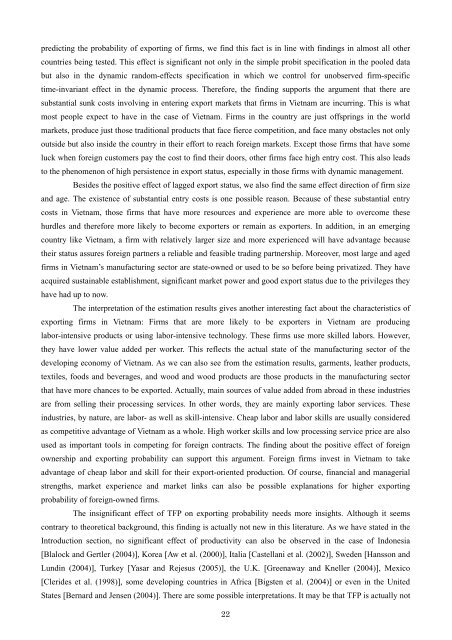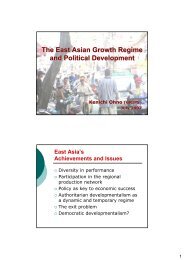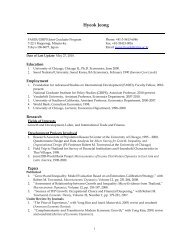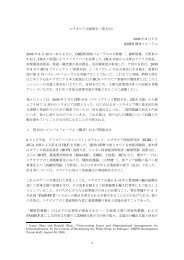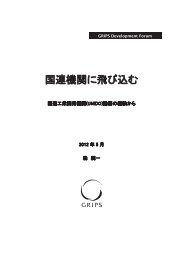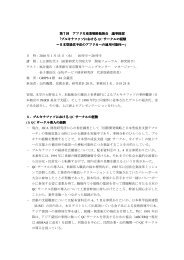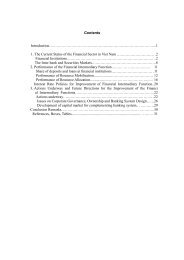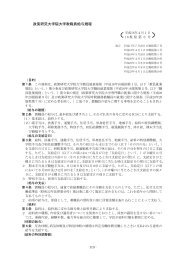Evidence from Firm-level Data in Vietnam
Evidence from Firm-level Data in Vietnam
Evidence from Firm-level Data in Vietnam
Create successful ePaper yourself
Turn your PDF publications into a flip-book with our unique Google optimized e-Paper software.
predict<strong>in</strong>g the probability of export<strong>in</strong>g of firms, we f<strong>in</strong>d this fact is <strong>in</strong> l<strong>in</strong>e with f<strong>in</strong>d<strong>in</strong>gs <strong>in</strong> almost all othercountries be<strong>in</strong>g tested. This effect is significant not only <strong>in</strong> the simple probit specification <strong>in</strong> the pooled databut also <strong>in</strong> the dynamic random-effects specification <strong>in</strong> which we control for unobserved firm-specifictime-<strong>in</strong>variant effect <strong>in</strong> the dynamic process. Therefore, the f<strong>in</strong>d<strong>in</strong>g supports the argument that there aresubstantial sunk costs <strong>in</strong>volv<strong>in</strong>g <strong>in</strong> enter<strong>in</strong>g export markets that firms <strong>in</strong> <strong>Vietnam</strong> are <strong>in</strong>curr<strong>in</strong>g. This is whatmost people expect to have <strong>in</strong> the case of <strong>Vietnam</strong>. <strong>Firm</strong>s <strong>in</strong> the country are just offspr<strong>in</strong>gs <strong>in</strong> the worldmarkets, produce just those traditional products that face fierce competition, and face many obstacles not onlyoutside but also <strong>in</strong>side the country <strong>in</strong> their effort to reach foreign markets. Except those firms that have someluck when foreign customers pay the cost to f<strong>in</strong>d their doors, other firms face high entry cost. This also leadsto the phenomenon of high persistence <strong>in</strong> export status, especially <strong>in</strong> those firms with dynamic management.Besides the positive effect of lagged export status, we also f<strong>in</strong>d the same effect direction of firm sizeand age. The existence of substantial entry costs is one possible reason. Because of these substantial entrycosts <strong>in</strong> <strong>Vietnam</strong>, those firms that have more resources and experience are more able to overcome thesehurdles and therefore more likely to become exporters or rema<strong>in</strong> as exporters. In addition, <strong>in</strong> an emerg<strong>in</strong>gcountry like <strong>Vietnam</strong>, a firm with relatively larger size and more experienced will have advantage becausetheir status assures foreign partners a reliable and feasible trad<strong>in</strong>g partnership. Moreover, most large and agedfirms <strong>in</strong> <strong>Vietnam</strong>’s manufactur<strong>in</strong>g sector are state-owned or used to be so before be<strong>in</strong>g privatized. They haveacquired susta<strong>in</strong>able establishment, significant market power and good export status due to the privileges theyhave had up to now.The <strong>in</strong>terpretation of the estimation results gives another <strong>in</strong>terest<strong>in</strong>g fact about the characteristics ofexport<strong>in</strong>g firms <strong>in</strong> <strong>Vietnam</strong>: <strong>Firm</strong>s that are more likely to be exporters <strong>in</strong> <strong>Vietnam</strong> are produc<strong>in</strong>glabor-<strong>in</strong>tensive products or us<strong>in</strong>g labor-<strong>in</strong>tensive technology. These firms use more skilled labors. However,they have lower value added per worker. This reflects the actual state of the manufactur<strong>in</strong>g sector of thedevelop<strong>in</strong>g economy of <strong>Vietnam</strong>. As we can also see <strong>from</strong> the estimation results, garments, leather products,textiles, foods and beverages, and wood and wood products are those products <strong>in</strong> the manufactur<strong>in</strong>g sectorthat have more chances to be exported. Actually, ma<strong>in</strong> sources of value added <strong>from</strong> abroad <strong>in</strong> these <strong>in</strong>dustriesare <strong>from</strong> sell<strong>in</strong>g their process<strong>in</strong>g services. In other words, they are ma<strong>in</strong>ly export<strong>in</strong>g labor services. These<strong>in</strong>dustries, by nature, are labor- as well as skill-<strong>in</strong>tensive. Cheap labor and labor skills are usually consideredas competitive advantage of <strong>Vietnam</strong> as a whole. High worker skills and low process<strong>in</strong>g service price are alsoused as important tools <strong>in</strong> compet<strong>in</strong>g for foreign contracts. The f<strong>in</strong>d<strong>in</strong>g about the positive effect of foreignownership and export<strong>in</strong>g probability can support this argument. Foreign firms <strong>in</strong>vest <strong>in</strong> <strong>Vietnam</strong> to takeadvantage of cheap labor and skill for their export-oriented production. Of course, f<strong>in</strong>ancial and managerialstrengths, market experience and market l<strong>in</strong>ks can also be possible explanations for higher export<strong>in</strong>gprobability of foreign-owned firms.The <strong>in</strong>significant effect of TFP on export<strong>in</strong>g probability needs more <strong>in</strong>sights. Although it seemscontrary to theoretical background, this f<strong>in</strong>d<strong>in</strong>g is actually not new <strong>in</strong> this literature. As we have stated <strong>in</strong> theIntroduction section, no significant effect of productivity can also be observed <strong>in</strong> the case of Indonesia[Blalock and Gertler (2004)], Korea [Aw et al. (2000)], Italia [Castellani et al. (2002)], Sweden [Hansson andLund<strong>in</strong> (2004)], Turkey [Yasar and Rejesus ( 2005)], the U.K. [Greenaway and Kneller (2004)], Mexico[Clerides et al. (1998)], some develop<strong>in</strong>g countries <strong>in</strong> Africa [Bigsten et al. (2004)] or even <strong>in</strong> the UnitedStates [Bernard and Jensen (2004)]. There are some possible <strong>in</strong>terpretations. It may be that TFP is actually not22


